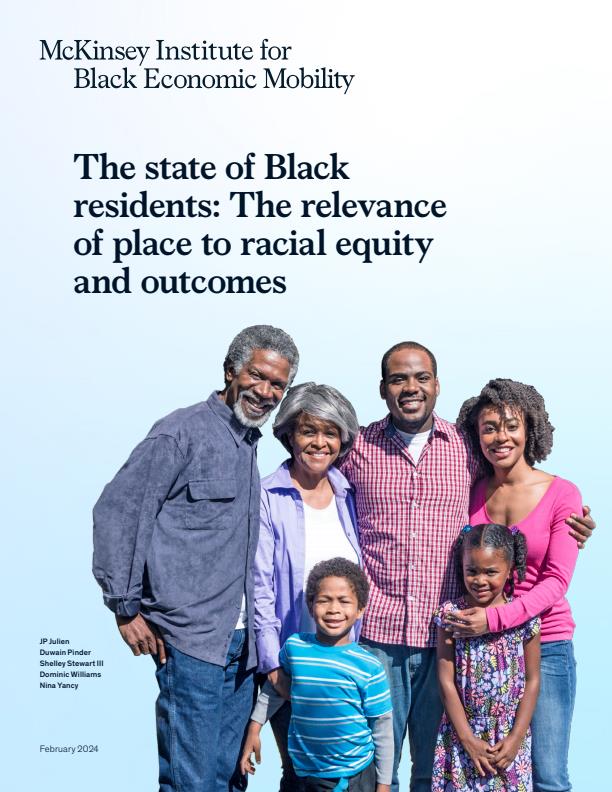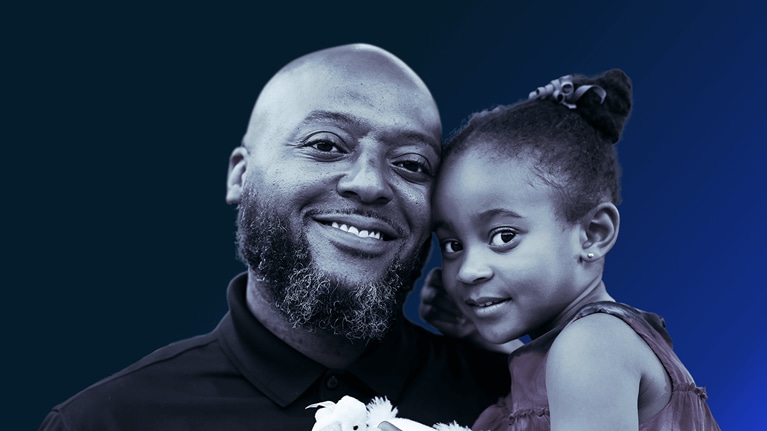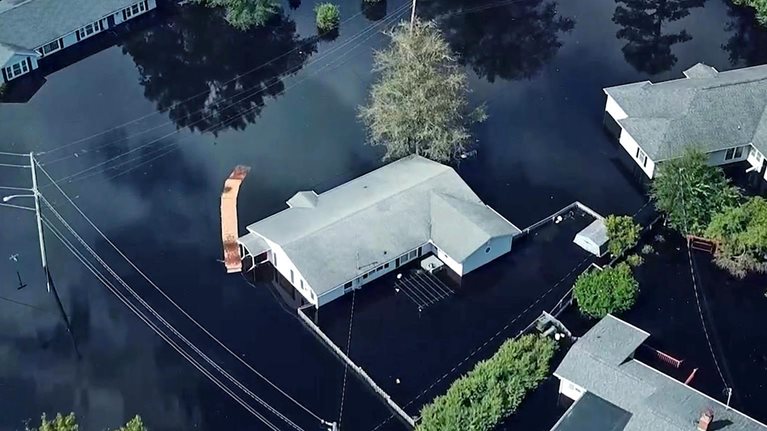Our 2021 report The economic state of Black America used a unique lens, exploring the barriers and opportunities Black Americans encounter in the various roles they play in the economy: as workers, business owners, savers and investors, consumers, and residents (in the context of community environments and public programs). Since then, we have followed up with a more detailed analysis of Black consumers. Here we similarly zoom in to analyze the Black resident experience.
People shape places, and places in turn shape outcomes for people. Racial disparities reported at the national level in the United States are broad averages that obscure what is happening in specific communities, whether they are stories of progress, stagnation, or regression.
To take on this multifaceted concept, we begin by defining a set of quality-of-life aspirations and looking at metrics related to them at the county level. We then aggregate the results for places with similar characteristics, including various types of American cities, suburbs, and rural counties. This approach enables us to examine which environments offer Black residents the best quality of life and which have gotten closer to the goal of creating more equitable outcomes.
The results show substantial differences in overall outcomes for Black residents across community profiles—as well as substantial gaps between Black and White residents in virtually every county. We find that America’s suburbs and exurbs currently seem to have the nation’s best balance of positive overall Black outcomes and parity. But even here, large disparities persist. Effectively, there is nowhere in the United States where outcomes for Black residents equal those of their White neighbors. Moreover, most places close to parity are small rural counties where outcomes are poor for all residents, regardless of race.
What works in a dynamic city with high inequality may not be right for a rural county with a stagnant economy.
We also look across the past decade to gauge the rate of progress. While multiple metrics have been improving for Black residents, those gains have not closed racial gaps in any meaningful way, as White outcomes improved to the same degree or even more so. At the current pace, it would take more than three centuries for Black residents across the nation to reach parity with their White neighbors. Progress has not yielded parity.
Mapping the gaps can help investors, companies, philanthropies, and public-sector leaders decide where and how to act. What works in a dynamic city with high inequality may not be right for a rural county with a stagnant economy. Our hope is that looking at people and places holistically will yield solutions that are transformative for Black residents and the trajectory of their communities.
We look at varied types of communities across the United States to assess the experiences of their Black residents
The United States has more than 3,000 counties. Some are thriving, some are distressed, and many more are somewhere in between. Mirroring previous McKinsey Global Institute research, we sort counties into distinct community profiles based on economic metrics, size, and other characteristics (Exhibit 1). We use this categorization to examine geographic variation in the economic, social, and physical well-being of residents in general and of Black residents in particular.
While our data covers a wider range of community profiles, we focus on the subset in which some 90 percent of Black Americans live. They fall into the following categories (Exhibit 2):
- Urban core. Twelve megacities, the nation’s largest urban centers, are home to 23 percent of the US population but 30 percent of all Black Americans. In addition, 13 high-growth hubs (places such as Austin, Charlotte, Minneapolis, and Silicon Valley) are home to almost 7 percent of the US population and a roughly equivalent share of the Black population. Both types of cities have high-growth industries, higher incomes, stronger job markets, and younger and more educated workforces than the rest of the country. Yet they have greater inequality and high costs of living.
- Suburbs and exurbs. We refer to the 271 counties that make up the extended suburbs of US cities as the urban periphery. They have the highest median household income of all community profiles. Home to about 17 percent of the US population but just under 12 percent of all Black Americans, they have attracted people moving out of dense urban settings in search of more space. A significant share of the population commutes into nearby urban areas.
- Mixed middle. This category includes 36 stable cities (such as Cincinnati, Jacksonville, and St. Louis) and 94 smaller independent economies (such as Lancaster, PA, and Winston-Salem, NC). These places have slower economic and job growth, higher unemployment, and moderately educated workforces. Stable cities are home to 12 percent of the US population but 19 percent of all Black Americans.
- Low-growth and rural areas. More than 2,000 rural counties are home to just over 18 percent of the US population and 15 percent of all Black Americans. Rural counties encompass somewhat better-performing places (stable rural counties) and struggling areas defined by slower economic growth (trailing rural counties). In both, populations are older, unemployment is higher, and educational attainment is lower than the national average.
Image description:
Three vertical percentage bar charts are shown side-by-side. The first one shows the percentages of the total US population (about 330 million people) living in each of the 13 community profiles. The other two charts compare the same distribution for White population (about 196 million people) and Black population (about 40 million). About 90 percent of Black American disproportionally reside in seven community profiles. Twelve megacities, the nation’s largest urban centers, are home to 23 percent of the US population but 30 percent of all Black Americans.
End of image description.
In each of these environments, we ground our analysis in a set of aspirations for all residents, regardless of race. These include a basic standard of living; financial stability; job opportunities with decent pay and good working conditions; long and healthy lives; opportunities to develop skills through affordable, quality education; stable and secure homes; physical and virtual connectivity; and stable communities. These are about more than surviving; they define what it takes for an individual or a family to thrive.
For each aspiration, we focus on between two and four priority metrics that convey how residents are faring. For example, to measure the aspiration for “long and healthy lives,” we assess life expectancy, health insurance coverage, and survey responses indicating overall physical and mental health for both Black and White residents of each US county. In all, we use 25 metrics to calculate “Black outcome scores,” then use those scores to compare and rank community profiles. Higher scores generally indicate greater prosperity and well-being relative to Black residents of other places.
Black outcomes are generally better in suburban and high-growth areas where Black residents are underrepresented
Overall, no community profile and no individual county stands out for having the highest Black outcome scores across the full range of metrics. But some rank at or near the top on multiple quality-of-life aspirations.
In broad terms, outcomes for Black residents are better in places with stronger economic foundations. However, these types of places have smaller Black populations (Exhibit 3).
The nation’s suburbs and exurbs have the highest overall Black outcome scores. They come out on top or as runner-up across seven of our eight aspirations, leading in metrics such as median household income ($79,000), workers in management roles (36 percent), life expectancy (78 years), and bachelor’s degree attainment (29 percent). But less than 12 percent of Black Americans live in the urban periphery, five percentage points lower than the share of the total US population in this community profile.
The second-highest overall Black outcome scores are in high-growth hubs (places such as Las Vegas and Seattle). Yet just over 6 percent of Black Americans live in these economically dynamic communities. Underrepresentation is notable in places such as San Jose/Silicon Valley, CA, and Austin, TX, where high-wage tech jobs are concentrated. While these places produce relatively high overall Black outcomes, their cost of living lowers their rankings for financial stability and housing.
Black Americans are overrepresented in two urban community profiles. More than 30 percent live in megacities (such as Atlanta, Chicago, Houston, Los Angeles, New York, Philadelphia, and Washington, DC). These urban areas have strong economies and above-average Black household incomes ($68,000); their Black residents match those in the urban periphery in college degree attainment and workers in management roles. But megacities also have high costs of living, reflected in the highest shares of Black residents with long commutes (29 percent) and outsize rent burdens (51 percent). Almost 19 percent of Black Americans live in less dynamic stable cities, where median incomes tend to be lower, at $52,000 (although lower costs of living make incomes go further). Stable cities rank poorly on health and longevity, and near last among all community profiles for Black residents’ mental and physical health and on measures of stable community.
Locations that fit the two rural community profiles are home to about 15 percent of all Black Americans—and rank near last on most Black outcome scores. Poverty and food insecurity rates among rural Black residents range from 28 to 32 percent; lower life expectancies (74 to 75 years) may reflect high uninsured rates (12 percent). However, rural communities do rank highly in housing (driven by lower rent burden, higher homeownership rates, and less overcrowding). Notably, Black Americans are overrepresented in trailing rural counties and underrepresented in stable rural counties.
Virtually nowhere in the nation are outcomes for Black residents on a par with those of their White neighbors
First, no US county with a sizable Black population has achieved parity—or even come close. Only 37 with more than 25 Black residents are close to parity, and collectively, these counties are home to just 39,000 Black residents, or 0.1 percent of the Black US population (Exhibit 4). We draw these insights by comparing Black resident outcomes to those of White residents of the same communities.
Image description:
A data visualization shows one thousand dots, representing all US Black residents. Each dot represents approximately 40,000 Black residents. 26 dots are highlighted in blue, indicating that 2.6 percent of all US Black residents have parity scores between 0.8 and 0.9 (a score of 1 means complete parity in outcomes with the White residents in the same communities). Only one dot is colored black, indicating the only 0.1 percent of the US Black population has a Black-White parity score of more than 0.9, and are close to parity.
End of image description.
Racial gaps in outcomes are largest in megacities and stable cities, which are collectively home to about half of all Black Americans (Exhibit 5). Black residents of megacities outearn their peers at a national level but earn roughly 60 percent of what White megacity residents do. The gaps in Black and White commute times are notable, showing that many Black residents have difficulty affording homes in convenient megacity neighborhoods.
Stable cities tend to have substantial racial gaps in incomes, the job market, and opportunities for education and skills development. They also have a notable Black–White gap in rent burden; Black renters are 20 percent more likely than White renters to spend at least 30 percent of their incomes on housing. Black residents in stable cities are also more than twice as likely as White residents to lack cars and broadband.
In addition, high-growth hubs, which post relatively good Black outcome scores, do poorly on parity, with sizable racial gaps on long and healthy lives, education for developing skills, and stable and secure homes.
Inequality in all three of these urban community profiles could be partly attributed to outmigration that has hollowed out the middle class over time. Also, major cities have historically enacted biased policies or provided public services unevenly across neighborhoods, locking in disadvantages for many Black residents.
Even in the urban periphery, Black outcome scores are just 64 percent of White outcome scores.
As noted above, the urban periphery has the highest overall Black outcomes. Yet even in this community profile, Black outcome scores are just 64 percent of White outcome scores. The racial gaps are especially large in housing. Only 52 percent of Black suburbanites own their homes, compared with 78 percent of their White peers.
Overall, rural areas (and particularly distressed rural areas) come closer to parity—but this reflects poor outcomes across the board for their entire populations. In cases like these, as well as in many urban settings, higher Black outcomes and parity can appear to present a trade-off (Exhibit 6).
Image description:
A scatterplot chart shows where Black residents in each of seven community profiles stand when we measure both outcomes and parity with Whites. The seven community profiles are megacities, high-growth hubs, stable cities, independent economies, urban periphery, stable rural counties and trailing rural counties. The suburbs (urban periphery profile) stand out for a balance of better Black outcomes and parity. Overall, rural areas (and particularly trailing rural counties) come closer to parity—but this reflects poor outcomes across the board for their entire populations. In cases like these, as well as in many urban settings, higher Black outcomes and parity can appear to present a trade-off.
End of image description.
Outcomes for Black residents generally improved over the past decade, but unevenly and with some exceptions
Are things at least trending in the right direction? Black residents did see progress, though not always swift, in most types of American communities from 2012 to 2021. Overall Black outcome scores improved in 73 percent of US counties that are collectively home to some 34 million Black residents. Stable cities, trailing rural counties, and high-growth hubs experienced the largest gains, with overall Black outcome scores rising 6.5 percent on average.
Looking more closely at what drove this progress reveals differences across community profiles. For example, stable cities saw lower Black unemployment rates, a shift away from Black representation in service roles and toward management roles, lower Black rent burdens, and improved vacancy and incarceration rates. Trailing rural counties showed progress across many categories, including a notable jump in broadband access for Black residents. Both high-growth hubs and megacities had higher bachelor’s degree attainment and lower shares of Black residents who attended college but did not obtain degrees (although this may reflect the industries in the urban core and the profiles of Black workers who tend to move to those locations).
Community profiles also experienced some common challenges over the past decade. All saw declining Black homeownership and increasing commute times. Other common challenges likely resulted from the pandemic, such as reduced labor force participation rates, lower preschool enrollment rates, and declines in self-reported mental health.
Results are mixed when it comes to narrowing racial gaps over time
While Black outcomes improved over the decade in most of the counties in each segment, only about half of those counties narrowed the gaps between the overall scores of Black and White residents. In most community profiles, the racial gaps in some metrics barely budged.
The quality of life is improving on multiple dimensions for everyone, but progress is taking significantly longer to filter through to Black residents. Their gains have not been rapid or dramatic enough to make up for disadvantaged starting points. In short, progress does not automatically equal parity, or even put Black Americans on a trajectory toward parity.
Trailing rural counties started and finished the decade with the highest level of parity among the seven community profiles (but, as noted above, the poorest overall outcomes for all residents). Over this time period, the gaps narrowed most in megacities and the urban periphery (Exhibit 7). These results may, of course, reflect long-term trends in who moves in and out.
In four of the aspirational categories, there was at least some progress toward parity across all seven community profiles:
- Standard of living: Rates of poverty and food insecurity for Black residents ended the decade lower in relation to the rates for White residents.
- Stable homes: While there was a growing racial gap in homeownership across all seven community profiles, this was offset by narrowed gaps in rent burdens and overcrowding.
- Connectivity: There was mixed progress in racial disparities in commute time, although racial gaps shrank across the board in households without car access and without a broadband subscription.
- Stable communities: Most places saw narrowed racial gaps in incarceration and vacancy rates.
The other four aspirations generally saw either limited progress or widening disparities over the past decade:
- Financial stability: Racial disparities in household income widened across rural America and in stable cities and high-growth hubs; elsewhere, there was scarcely any movement.
- Job opportunities: Racial gaps in unemployment and labor force participation narrowed slightly in most community profiles, but gaps in the shares of Black and White workers in management roles widened. There was little overall change in this category as a result.
- Long and healthy lives: Gaps in the uninsured share of the Black and White populations widened in cities, narrowed in rural areas, and remained little changed in the urban periphery.
- Skill development: Racial gaps in bachelor’s degree attainment improved slightly in all community profiles, but disparities in residents who started college but did not graduate worsened. Moreover, gaps between the Black and White populations without high school diplomas barely changed.
At current rates of change, how long would it take to improve outcomes and achieve racial parity?
First, we consider how long it would take to lift all other Black residents to the levels of prosperity and well-being enjoyed by those in the urban periphery (currently the top-performing community profile). At the current pace of change, it could take anywhere from 10 to 30 years for all other areas of the nation to match the suburbs and exurbs in overall outcomes for Black residents. Cities would catch up sooner.
Second, we estimate how long it would take for Black Americans to reach parity with their White neighbors. Based on the rate of change between 2012 and 2021, it could take more than three centuries for all community profiles to reach parity (Exhibit 8). For simplicity, this analysis assumes that outcomes for White residents remain at today’s levels. But based on history, these will likely continue to improve—which means that our estimate, while sobering, is actually conservative.
Image description:
A table shows how many years it would take Black American residents in each of seven community profiles to achieve parity their White neighbors at the current rate of progress. The seven community profiles are: trailing rural counties (it would take 110 years to achieve parity), urban periphery (120 years), megacities (160 years), high-growth hubs (210 years), independent economies (220 years), stable cities (240 years), and trailing rural counties (320 years).
End of image description.
In short, recent improvements have taken a small chisel to a large mountain of past inequities that have accrued over time. Without faster change, the United States would not achieve racial parity in our lifetimes, or even in our children’s or grandchildren’s lifetimes.
Solutions need different forms in different communities, but getting to parity requires more speed and scale than ever before
Glacial progress in leveling the playing field denies Black residents both economic and social opportunities. Since the resident experience has cascading effects on their roles as workers, consumers, savers, and business owners, the United States is shortchanging the broader economy by not addressing issues that hinder millions of people from reaching their full potential. To prevent these disparities from lingering for future generations, all stakeholders will need to bring fresh energy and urgency to engaging on solutions.
To prevent these disparities from lingering for future generations, all stakeholders will need to bring fresh energy and urgency to engaging on solutions.
But where to start? One option is to take a place-based approach, investing in a range of initiatives within specific communities. The Harlem Children’s Zone is a notable example of this approach, offering comprehensive “cradle-to-career” programming for low-income children and families with an emphasis on educational achievement. Other examples include the East Baltimore Development Initiative, Atlanta’s East Lake Foundation, and San Diego’s City Heights Initiative. National nonprofits, philanthropic investors, and government entities can support these types of local efforts.
Another option is taking a thematic approach to solutions, focusing on key levers that could improve outcomes across many communities. It is beyond the scope of this research to offer solutions for the full range of issues raised. But we do look at two priority areas for action: affordable housing and the birth-to-kindergarten care infrastructure. We single them out because meeting these needs could have positive ripple effects on other aspects of well-being. They are critical for getting many low- and middle-income residents of all races to a base level of thriving today, with lasting benefits for Black residents that could eventually improve racial parity as well. These issues illustrate how challenges and solutions can differ across community profiles.
Affordable housing: Density defines the nature of the challenge
Across the United States, about half of all renter households spend more than 30 percent of their income on housing; a quarter spend more than 50 percent. By contrast, only 22 percent of homeowners are either moderately or severely cost burdened. Together, these dynamics make housing unaffordability particularly acute for Black residents, who are both less likely to own homes and more likely to be cost burdened.
Recent research estimates that 7.3 million additional affordable homes are needed across the United States, particularly to meet the needs of extremely low-income renters. Based on average costs reported by states and cities and the distribution of need across community profiles, we estimate that building costs could run up to $2.4 trillion. While that is an enormous sum, it would yield real returns—and the projects themselves generate jobs and economic activity. Tackling this shortage, particularly by adding affordable units in low-poverty neighborhoods and mixed-income developments, could help improve educational outcomes and economic mobility for the next generation.
Adding affordable housing in low-poverty neighborhoods and mixed-income developments could improve economic mobility for the next generation.
However, large-scale building needs to be implemented carefully so that revitalization does not lead to displacement. Projects would need community input and fair processes for allocating new units, balancing the needs of new arrivals and current residents.
In megacities, high-growth hubs, and stable cities, where approximately half of Black households are rent burdened, one of the most important strategies is unlocking land. This could involve allowing taller projects around transit, reducing minimum lot sizes, and building infill housing on vacant parcels. Cities can also streamline approval processes and allow bigger projects if a certain percentage of units is reserved for low-income renters.
Private- and social-sector actors have a large role to play as well. In the post-pandemic world, developers can work with cities to convert commercial properties into housing. Adopting prefab construction at scale could reduce the development costs of multifamily housing by 5 to 15 percent. Nonprofits can also develop new housing or acquire and renovate residential communities to preserve existing affordable housing.
While the scarcity of land drives the housing crunch in dense cities, rural areas have the opposite problem. They have land, but their more fragmented nature and smaller populations make it harder to attract capital. These regions can focus on rehabbing existing homes. The US Department of Agriculture’s Rural Development Program, for example, offers low-cost loans and grants to low-income homeowners, often partnering with Habitat for Humanity chapters to execute repairs. Repurposing abandoned structures such as storefronts and warehouses can inject new life into neglected main streets—but just as in cities, some kind of public or philanthropic element may be needed to build affordability into revitalization projects.
Early childhood education builds a foundation for better academic and professional outcomes
High-quality early childhood development programs can change the trajectory of disadvantaged children’s lives. Formal childcare and pre-K also can be critical to parents’ ability to work and provide for their families. Among families who pay for childcare, the cost eats up 23 percent of Black families’ income on average, compared with 15 percent for White families. This can leave many Black parents with the dilemma of either spending an unsustainable amount on childcare or exiting the workforce.
While 53 percent of children aged three to four were enrolled in preschool as of 2022, this means almost half of this age group—or 3.5 million children—are not enrolled. Moreover, most three- and four-year-old preschool students are in privately funded programs. If we aspire to the goal of giving all three- and four-year-olds access to high-quality public preschool, the estimated number of additional student places needed increases to a total of about 6.1 million.
Making publicly funded preschool universal in our seven community profiles implies the need for an additional 614,000 educators and paraprofessionals, at a cost of some $78 billion annually. This is based on a study estimating the cost of a high-quality, full-day pre-K program at $12,700 per child, a figure that approaches national spending per child on K–12 education. The cost is linked to employing preschool teachers with specialized training and paying them living wages—which would have a double benefit for Black economic mobility, since Black women make up about 17 percent of early childhood educators. The returns on this type of investment could be substantial. Some studies have estimated that high-quality early childhood education for disadvantaged children can deliver a return on investment of anywhere from 7 to 13 percent.
Current spending is only about half that figure per child, a level that has barely budged in two decades. Even in the cities and states committed to pre-K for all, shortfalls mean that not every child who tries to enroll is able to do so. Children whose parents may lack resources or information about enrollment processes are least likely to gain access.
Given the need to boost outcomes (and parity) for low-income children, it could seem logical to consider public programs for only those families with the greatest need. But universal programs, while more expensive, can deliver commensurately larger benefits. Exposure to diverse classmates has been shown to have a positive effect on development. Low-income families are more likely to enroll in universal programs than in targeted programs for which they qualify. Further streamlining application processes and boosting parental awareness through outreach campaigns could accelerate progress toward parity.
While many urban children still cannot access high-quality preschool, the nation’s cities do have advantages—such as the presence of colleges and universities, and larger school systems—on which to build. Density and transit mean that preschools are generally accessible (although density also makes it more expensive to build new capacity in these areas). The challenges differ in rural areas, where families are more likely to rely on informal home-based preschool rather than center-based programs. Nearly two-thirds of rural families live in so-called childcare deserts. Small populations may make it hard for private providers to stay afloat.
Without greater and more sustained public funding, early childhood education will remain patchwork. While advocating for system-level change, employers and philanthropists can fill some of these gaps. A small but growing number of companies—including Marriott, Tyson Foods, and Patagonia—have begun offering their own on-site daycare and pre-K programs. One recent report noted that while few philanthropists prioritize early childhood education, their willingness to give rises dramatically when they are presented with evidence of its impact. There are individuals and foundations with the resources to make a difference; presenting them with a fact base and clear funding opportunities could mobilize them.























